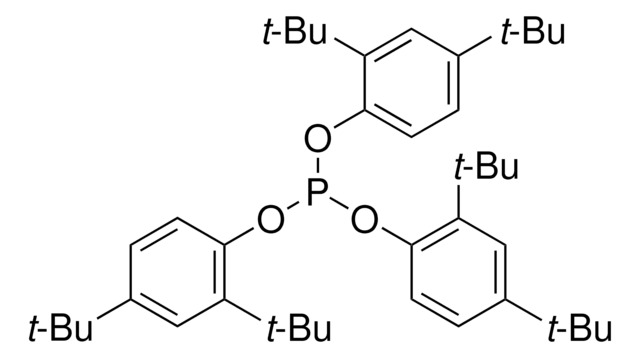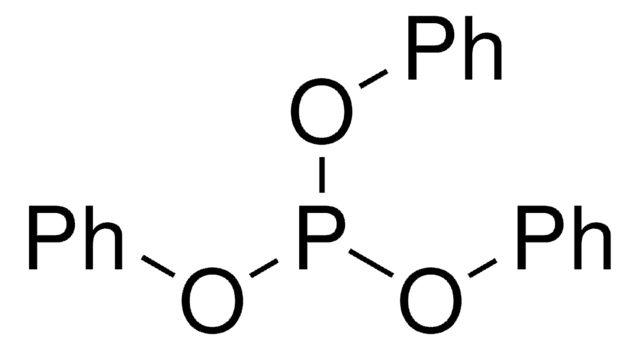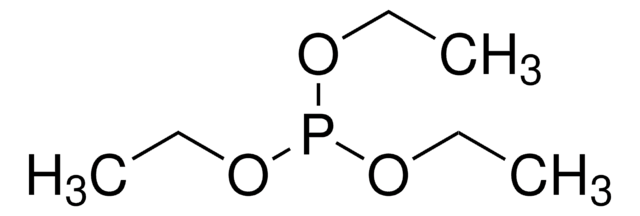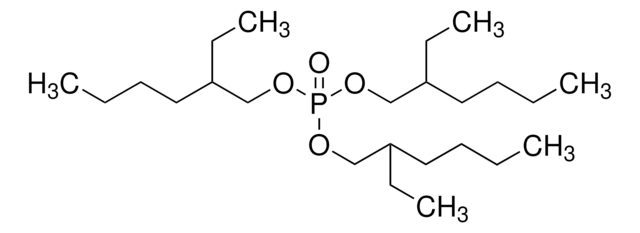441805
Tris(nonylphenyl)phosphit
Synonym(e):
Tri(monononylphenyl) phosphite
About This Item
Empfohlene Produkte
Form
liquid
Qualitätsniveau
Brechungsindex
n20/D 1.528 (lit.)
bp
>360 °C (lit.)
Dichte
0.99 g/mL at 25 °C (lit.)
SMILES String
CCCCCCCCCc1ccccc1OP(Oc2ccccc2CCCCCCCCC)Oc3ccccc3CCCCCCCCC
InChI
1S/C45H69O3P/c1-4-7-10-13-16-19-22-31-40-34-25-28-37-43(40)46-49(47-44-38-29-26-35-41(44)32-23-20-17-14-11-8-5-2)48-45-39-30-27-36-42(45)33-24-21-18-15-12-9-6-3/h25-30,34-39H,4-24,31-33H2,1-3H3
InChIKey
WGKLOLBTFWFKOD-UHFFFAOYSA-N
Allgemeine Beschreibung
Anwendung
Signalwort
Danger
H-Sätze
Gefahreneinstufungen
Aquatic Acute 1 - Aquatic Chronic 1 - Eye Dam. 1 - Repr. 2 - Skin Irrit. 2 - Skin Sens. 1
Lagerklassenschlüssel
10 - Combustible liquids
WGK
WGK 3
Flammpunkt (°F)
404.6 °F - closed cup
Flammpunkt (°C)
207 °C - closed cup
Persönliche Schutzausrüstung
Eyeshields, Gloves
Hier finden Sie alle aktuellen Versionen:
Besitzen Sie dieses Produkt bereits?
In der Dokumentenbibliothek finden Sie die Dokumentation zu den Produkten, die Sie kürzlich erworben haben.
Kunden haben sich ebenfalls angesehen
Unser Team von Wissenschaftlern verfügt über Erfahrung in allen Forschungsbereichen einschließlich Life Science, Materialwissenschaften, chemischer Synthese, Chromatographie, Analytik und vielen mehr..
Setzen Sie sich mit dem technischen Dienst in Verbindung.





![3,9-Bis(octadecyloxy)-2,4,8,10-tetraoxa-3,9-diphosphaspiro[5.5]undecan](/deepweb/assets/sigmaaldrich/product/structures/426/453/2ce260eb-38be-4a9d-b432-9710a0c9a290/640/2ce260eb-38be-4a9d-b432-9710a0c9a290.png)





![3,9-Bis(2,4-dicumylphenoxy)-2,4,8,10-tetraoxa-3,9-diphosphaspiro[5.5]undecan](/deepweb/assets/sigmaaldrich/product/structures/163/089/23367906-df78-4721-b2a6-690cd4c2a9a9/640/23367906-df78-4721-b2a6-690cd4c2a9a9.png)


